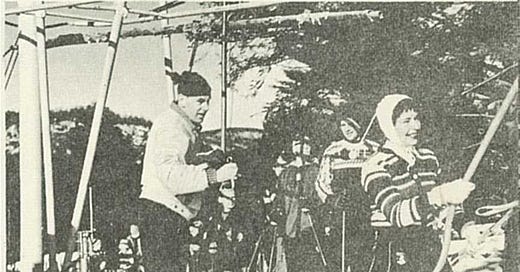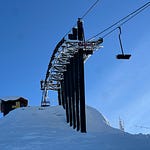The Storm Skiing Podcast is sponsored by Spot and Mountain Gazette - Listen to the podcast for discount codes on Mountain Gazette subscriptions and merch.
Who
David Cronheim, President of the Shareholders Corporation for Hickory Ski Center, New York
Recorded on
January 5, 2022
Why I interviewed him
Because these places… gone. Once-spectacular ski areas towering out of the wilderness, lifts and trails and little shacks arrayed along the base and splendid people standing about bareheaded in sweaters, unbothered, as though the jacket and hat were inventions of weak-willed generations to come. New York is littered with their ghosts. Dutchess, poised spectacularly on the Hudson, rising a thousand feet over the town of Beacon. Wing Hollow, site of a still-unsolved double-murder, 800 feet funneling off two peaks in the state’s Western snowbelt. Scotch Valley, a spiderweb of trails cascading down a Catskills ridge. The trails are still visible on Google Maps. The lifts remain. But the ski area as an operating concern is long gone.
Most of these ski areas are never coming back. But Hickory and its 1,200 vertical feet of all-natural terrain, narrow trails and glades, and shoulder-jerking Pomas lifted from our black-and-white past, could be. This is the most important story in New York skiing right now, and I had to hear more.

What we talked about
Hickory’s founding by 10th Mountain Division veterans returning from World War II; the history of the ski area’s unique lift system; Hickory ownership over the years; why Hickory closed in 2005 and again in 2015 after decades of continuous operation; the incredible costs of maintaining even a basic ski area; skiing on a one-inch snow base; how snowmaking would transform Hickory into “a steeper West Mountain” and why the ski area won’t do that; the thrill and challenge of riding the antique Pomas; why Hickory’s upper mountain can only accommodate 200 skiers per day; the novel license and pass model that will “harness the enthusiasm” that surrounds Hickory and bring the ski area back in a sustainable way; why “there’s nothing about Hickory that makes economic sense”; Hickory’s distinct upper and lower mountains and why the ski area is creating different access tiers for each of them; why the mountain won’t be selling upper-mountain lift tickets; how non-license-holders will be able to access the upper mountain; why the future of Hickory relies on “sharing the risk of a bad winter”; charging for uphill access; the gnarly gorgeous terrain of the Three Sisters Range and whether the ski area could ever expand onto its neighboring mountains; the intense physical experience of skiing Hickory and how that colors the social experience; finding parts for decades-old lifts; the hassle of certifying ancient lifts in New York State; the inevitable comparisons to Mad River Glen; why the Pomas will likely last as long as Hickory does; how the lower-mountain lift system could eventually evolve; whether the lower mountain could ever see snowmaking or night-skiing lights; the condition of Hickory’s spectacular lodge; what a successful season would look like; and what the ski area’s operating schedule might look like.

Why I thought that now was a good time for this interview
It’s not fair to say that Hickory ever really died. The owner never said, “I give up,” as the folks at Ski Blandford and Granite Gorge and Toggenburg have done in recent years. Rumors and reports proliferated since the last time Poma 1 and 2 carried skiers to the mountain’s summit seven or eight years ago. But winter after winter the place sat idle. There was no obvious way to revive it: the place has no snowmaking, grooming technology from the Nixon administration, low-capacity surface lifts that are too aggressive for 90 percent of the skiing public. Maintenance costs were high, revenue low. What could be done?
Saving Hickory would take some creativity and shared sacrifice, a critical mass of skiers willing to invest in a ski area that may go all winter long without opening. An all-natural-snow mountain in New York is a strange enough conceit. This isn’t Utah, after all. But an all-natural-snow mountain in 2022 New York, with its erratic snowfalls, is puzzling. Add in the fact that the ski area is right down the road from Gore, with its 14 lifts and 110 trails and 2,500-foot vertical drop and state-funded gazillion-gallon snowmaking system, and the notion of a sustainable Hickory may seem downright insane.
But completely sane people rarely accomplish anything interesting or novel. It turned out that there was (probably) a way to bring Hickory back to the surface. A way to ride again. It’s creative and compelling, modest in scope but valiant in its ambition. Skiers invested in preserving old-school skiing and motivated to lock-in Poma access on those rare New York snow days will each have to chip in $300 per year to cover those basic operations. When it snows, these so-called license holders will have to pay for an upper-mountain lift ticket. No one else other than guests of a license-holder will be able to get them. There are other elements to the plan: opening lower-mountain access to the general public, bringing in school groups, and charging uphillers to access the ski area at will. New York Ski Blog lays the whole pricing structure out here.
Will the plan work? I don’t know. I think it will. I hope it does. The folks who love Hickory do too. Listen to this conversation and you will become one of them pretty quick. Hope to see you out there.
Why you should ski Hickory
There is a certain breed of insufferable Big-Mountain Bro who spends approximately 85 percent of his waking hours trolling social media for ski posts portraying anything other than four feet of powder dumping off a Valdez spine. “Where’s the snow?” says this idiot, when looking at a picture filled with snow. Big-Mountain Bro will never let the world forget that he spent five days heli-skiing in 2003 and that anything else is now beneath him.
While that guy is busy updating his will to make sure this fact is etched on his tombstone, the rest of us are skiing anything we can, whenever we can. Some days, this means zooming around a ski area sprawling over five peaks interlaced with chairlifts fast enough to break the sound barrier. Other days it means dragging kids around a flat beside a Magic Carpet. But Hickory gives us something else: raw, throwback skiing. The best of nature crossed with the best technology 1965 could produce. It’s rough and improvisational and steep and way more than most of the skiing public could handle. But for those who can handle it and for those that can get there, Hickory will give you a ski experience unmatched and unforgettable.
For everyone else, for kids, for beginners, for the curious or the anxious, there’s the lower mountain, Hickory’s pony-tow and T-bar learners area. Together they’re pretty cool – like two ski areas stacked atop each other. Big-Mountain Bro scoffs. The rest of us can marvel that such a thing still exists, that someone came up with a way to make it work, and that it does. It’s a story worth being part of.
Plus, well, this could be you:


















Share this post